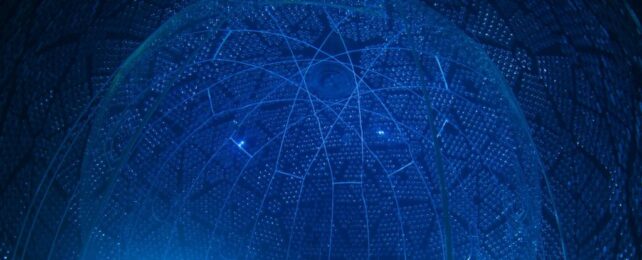ARTICLE AD
 The SNO+ detector. (SNOLAB)
The SNO+ detector. (SNOLAB)
Back in 2018, a tank of the purest water, buried under kilometers of rock in Ontario, Canada, flashed as barely detectable particle slammed through its molecules.
It was the first time that water has been used to detect a particle known as an antineutrino, which originated from a nuclear reactor more than 240 kilometers (150 miles) away. This incredible breakthrough promises neutrino experiments and monitoring technology that use inexpensive, easily acquirable and safe materials.
As some of the most abundant particles in the Universe, neutrinos are odd little things with a lot of potential for revealing deeper insights into the Universe. Unfortunately they are almost massless, carry no charge, and barely interact with other particles at all. They mostly stream through space and rock alike, as though all matter was incorporeal. There's a reason they're known as ghost particles.
Antineutrinos are the antiparticle counterpart to neutrinos. Usually, an antiparticle has the opposite charge to its particle equivalent; the antiparticle of the negatively charged electron, for example, is the positively charged positron. Since neutrinos don't carry a charge, scientists can only tell the two apart based on the fact an electron neutrino will pop into existence alongside a positron, while an electron antineutrino appears with an electron.
Electron antineutrinos are emitted during nuclear beta decay, a type of radioactive decay in which a neutron decays into a proton, an electron, and antineutrino. One of these electron antineutrinos can then interact with a proton to produce a positron and a neutron, a reaction known as inverse beta decay.
Large, liquid filled tanks lined with photomultiplier tubes are used to detect this particular kind of decay. They're designed to capture the faint glow of Cherenkov radiation created by charged particles moving faster than light can travel through the liquid, similar to the sonic boom generated by breaking the sound barrier. So they're very sensitive to very faint light.
Antineutrinos are produced in prodigious quantities by nuclear reactors, but they're relatively low energy, which makes them difficult to detect.
Enter SNO+. Buried beneath more than 2 kilometers (1.24 miles) of rock, it's the world's deepest underground laboratory. This rock shielding provides an effective barrier against interference by cosmic rays, allowing scientists to obtain exceptionally well resolved signals.
Today the lab's 780-tonne spherical tank is filled with linear alkylbenzene, a liquid scintillator that amplifies light. Back in 2018, while the facility was undergoing calibration, it was filled with ultrapure water.
Combing through the 190 days' worth of data collected during that calibration phase back in 2018, the SNO+ collaboration found evidence of inverse beta decay. The neutron produced during this process is captured by a hydrogen nucleus in the water, which in turn produces a soft bloom of light at a very specific energy level, 2.2 megaelectronvolts.
Water Cherenkov detectors generally struggle to detect signals below 3 megaelectronvolts; but a water-filled SNO+ was able to detect down to 1.4 megaelectronvolts. This produces an efficiency of around 50 percent for detecting signals at 2.2 megaelectronvolts, so the team thought it was worth their luck looking for signs of inverse beta decay.
An analysis of a candidate signal determined that it was likely produced by an antineutrino, with a confidence level of 3 sigma – a 99.7 percent probability.
The result suggests that water detectors could be used to monitor the power production of nuclear reactors.
Meanwhile, SNO+ is being put to use to help understand neutrinos and antineutrinos better. Because neutrinos are impossible to measure directly, we don't know much about them. One of the biggest questions is whether neutrinos and antineutrinos are the exact same particle. A rare, never-before-seen decay would answer this question. SNO+ is currently looking for this decay.
"It intrigues us that pure water can be used to measure antineutrinos from reactors and at such large distances," said physicist Logan Lebanowski of the SNO+ collaboration and the University of California, Berkeley, back in March 2023.
"We spent significant effort to extract a handful of signals from 190 days of data. The result is gratifying."
The research has been published in Physical Review Letters.
A version of this article was first published in April 2023.

 1 month ago
22
1 month ago
22 

